NORTH WALES COAST RAILWAY:NOTICE
BOARD
Rheilffordd arfordir gogledd Cymru: Hysbysfwrdd
07 January 2013
 Last issue
Last issue Archive
Archive Share this issue
Tweet
News of updates
@nwrail1
Contributions and comments are encouraged: see the Contributions Page
This site is dedicated to all our regular contributors and supporters, and especially the rail staff of North Wales.
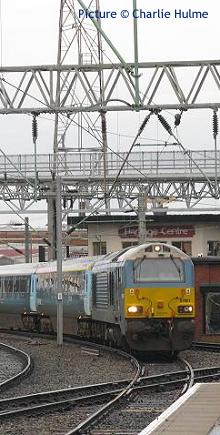
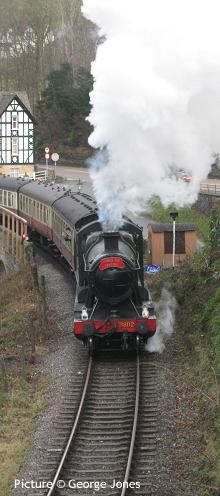

Recent issues
23/30 December 2012
Irish railways in the 1990's
Radio Survey 37s
Relief on a Wet Day
Chester, 9 December - report by Roly High
A sorry sight - the Duke of Lancaster
Flooding
17 December 2012
Picture news
Llandudno 1990
Santa at Llangollen - report by George Jones
On the Welsh Highland - with John Roobottom
Advent on the Rhyl Miniature Railway - report by John
Past Times - with John Hobbs
Talyllyn progress - based on a press release
More on Liverpool Road and the Ordsall Chord
10 December 2012
Gobowen station Christmas Cafe
Pendolino no more
Feedback
Princess Elizabeth visits Chester
RCTS meeting 17 December
Edinburgh Statesman
Bala Santa
Llandudno lifting - report by Peter Lloyd
Loco-hauled for Christmas
Rugby special
High-speed train?
Tunnel cannabis farmers charged
Holiday Snap
03 December 2012
Christmas is coming
Past Times - with John Hobbs
A visit to Cardiff - report by Roly High
The 'Rheidol Road' Special - report by Denis Bates
Manchester Metrolink developments - pictures by Greg Mape
A Winter outing - report by Martin Evans
The Pannier Rambler - report by Richard Putley
Llandudno station before improvement - pictures by Roly High.
Video Corner
26 November 2012
End of the Pendolino Drag?
Flooding
Looking back at the Dyserth branch - with John Hobbs
To Birmingham for the Model Railway show - with Roly High.
For Sale: Penmaenmawr station house
Coal to Penyffordd
Marches line resignalling
Bangor Repair Shed - last days
North Wales electrification?
MOSI and the Ordsall Chord - report by Charlie Hulme
19 November 2012
Bangor Shed mystery
Network Rail assortment
Christmas at Bala
Hop on our 'Merry-Maker' - with Stephen Hughes
About Mark 3 coach bogies
Ayrshire Yeomanry at Llangollen - report by George Jones
Club 55 to Barry - report by Richard Fleckney
Christmas Reading
Sandy Lane crossing - pictures by Roly High
Bridges at Berwyn - report by George Jones
12 November 2012
Saturday 10 November: Rugby Special etc.
Timetable change looms
Grinding in North Wales - pictures by Roly High
Ffestiniog scenes - by Ian Pilkington
Princess leaves Ffestiniog pub - report by Eryl Crump
'Grandad'
Mouldsworth to Helsby memories - by Dave Sallery
Cambrian needs nine million pounds
Come to sunny Rhyl
Derbyshire in a day - with Alan Crawshaw
Brush Corner
The new coaches in close-up - pictures by M.Lloyd Davies
Hawarden from the Air - report by George Jones
05 November 2012
DB Schenker under fire
Changeable weather on Saturday 3 November
Double Grids on timber train - report by Mark Riley
New carriages for Snowdon
Remembrance at Llangollen
Birkenhead Tramway troubles
Picture miscellany
Forthcoming events
This list may be out of date if you are reading an archived page. For the current list visit our Calendar.
January 2013
Thursday 10 January Llandudno and Conwy Valley Railway Society “Early Railways of Gwynedd 1790- 1830’s” Dr Dafydd Gwynn
Friday 11 January Altrincham Electric Railway Society "Transport around Manchester from 1750" a colour slide presentation by Chris Makepeace.
Saturday 12 January Railway and Canal Historical Society Group Annual General Meeting commencing at 13:45 followed at 14:30 by "Members Choice".
Monday 14 January Wrexham Railway Society 'Railway Quiz' Phil Davies
Thursday 17 January LCGB North West Keith Naylor "Isle of Wight Railways"
Monday 21 January RCTS Chester Branch A.G.M. followed By British slides between 1983 & 2010 By Alan Donaldson.
Thursday 31 January Merseyside Railway History Group Geoff Coward: Northeast China Steam 2002
February 2013
Friday 1 February Clwyd Railway Circle Gordon Davies “American Wanderings 2, the Great Plains Drifter” - Recollections of Gordon’s trip in 2008, covering the largest open cast mine in Wyoming plus the world’s largest marshalling yard.
Friday 8 February Altrincham Electric Railway Society "The Lynton & Barnstaple Railway" a digital presentation by Bob Barnard.
Saturday 9 February Railway and Canal Historical Society "The Manchester Bolton and Bury Canal, its history and restoration" by Dr. Paul Hindle.
Monday 11 February Wrexham Railway Society 'The Wrexham - Bidston Line' David Rapson.
Thursday 14 February Llandudno and Conwy Valley Railway Society “My Life in Crewe Works” Arthur Jones
Monday 18 February RCTS Chester The Northern Hub. A Talk By Duncan Law, Senior Programme Development Manager, Network Rail.
Thursday 21 February LCGB North West Mike Taylor "Preston and North"
Thursday 28 February Merseyside Railway History Group Dave Southern: Rails to Blaenau Ffestiniog
March 2013
Friday 1 March Clwyd Railway Circle The Committee & Larry Davies. AGM followed by the talk “60 years ago – Diamond days” After the formality is over, we look forward to the talk by one of our favourite speakers.
Friday 8 March Altrincham Electric Railway Society "German Narrow Gauge Steam" a colour slide presentation by John Owen.
Saturday 9 March Railway and Canal Historical Society "Lost Canals of the East Midlands" by the Society's President, Dr. Wendy Freer
Monday 11 March Wrexham Railway Society 'A Circular Tour Of North Wales' John Hobbs
Thursday 14 March Llandudno and Conwy Valley Railway Society “Polish Steam” Brian Bollington & Pete Hanahoe
Monday 18 March RCTS Chester B.R in the early 1980’s By Tom Heavyside.
Thursday 21 March LCGB North West Tony Harrison "The Dragon's Last Roar"
Thursday 28 March Merseyside Railway History Group AGM: Members Slides
April 2013
Friday 5 April Clwyd Railway Circle Michael Murphy 'Liverpool Overhead Railway' To finish off the season, a highly recommended speaker known for his light-hearted style of presentation. The talk will be followed by film footage of the railway in its heyday.
Monday 8 April Wrexham Railway Society 'The Railways Of Scotland' Les Nixon
Thursday 11 April Llandudno and Conwy Valley Railway Society “Chester to Holyhead English Electric traction 1984 – Present day” Steve Morris
Friday 12 April Altrincham Electric Railway Society "Current Developments on Metrolink" a digital presentation by Tony Williams, Manchester Area Officer, Light Rail Transit Association.
Saturday 13 April Railway and Canal Historical Society "The General Strike & the Railways" by Dr. Robin Smith
Monday 15 April RCTS Chester Even Further Down Under: New Zealand In 2011 & 2012 By Geoff Morris.
Thursday 18 April LCGB North West John Sloane 'Steam Sheds and Diesel Depots'
Thursday 25 April Merseyside Railway History Group Richard Kells : Quiz and informal evening
Sat - Sun 9 -10 February Llangollen Railway Days Out with Thomas
Fri - Sun 15-17 February Llangollen Railway Days Out with Thomas
23 March Llangollen Railway Diesel day
13 April Llangollen Railway Real Ale train evening
19-21 April Llangollen Railway Spring Steam gala with return of the steam Railmotor 93 and newly restored Auto Trailer 92
May 2013
Thursday 9 May Llandudno and Conwy Valley Railway Society “The Buckley Railway” Paul Davies
Saturday 11 May Llangollen Railway Murder Mystery
Thursday 16 May LCGB North West AGM and Members/Visitors Slides & Digital Photos.
Sunday 19 May Llangollen Railway Teddy Bears Picnic
June 2013
1-2 June Llangollen Railway Day Out with Thomas weekend
8 June Llangollen Railway Real Ale train evening
22-23 June Llangollen Railway Heritage Railcar Gala
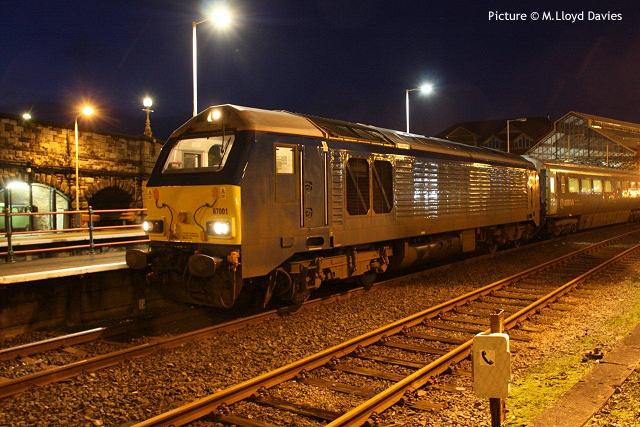
67 001 prepares to depart from Holyhead with the 17:15 extra to Crewe, 29 December. Picture by M.Lloyd Davies.
Engineering New Year
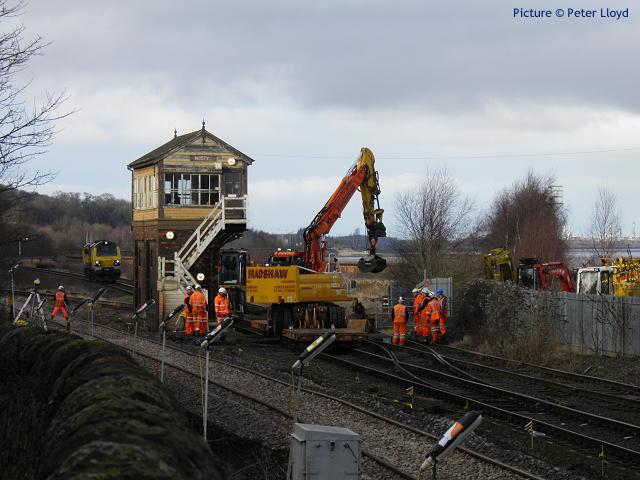
About a mile of track on the down line was replaced at Mostyn over the weekend of 5-6 January. Here are some pictures taken on Sunday 6 January by Peter Lloyd; interestingly, Freightliner Class 70 locos were in charge of all the trains of materials. Above, activity around Mostyn signalbox, which draws the attention by its appalling condition. It is still open, although only used when required, which is not very often since the connection to Mostyn Dock was last used in 2008. A Grade II listed building, it is now the only working signalbox on the Coast line that has not been refurbished with new windows and still retains its London and North Western Railway 'look.' Like all other 'boxes on the line it is due to be abolished within the next few years, all signalling control being transferred to Cardiff, and whether it can be retained for heritage reasons after that (assuming it doesn't fall down earlier) seems doubtful, especially since it can only be reached by walking across the track.
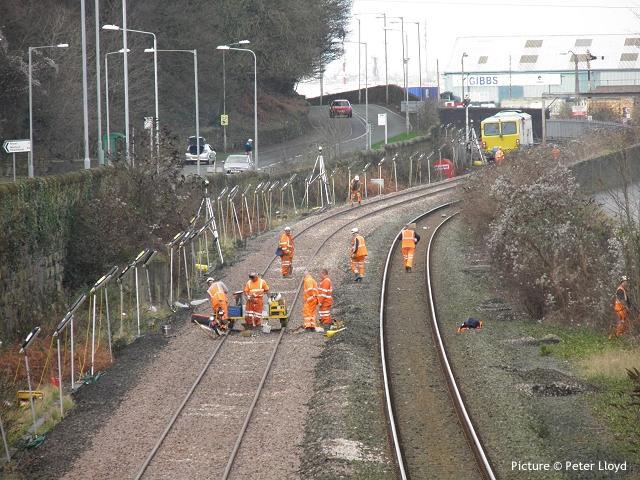
Finishing touches to the new track, with a track machine (Babcock Rail tamper DR79304) in attendance. Note the pink granite ballast from Cumbria which is now appearing everywhere in the area since Network Rail no longer buys its stone from Penmaenmawr Quarry. Loads of stone which have been taken out from there recently have been for Manchester Metrolink. No, those workers are not applying dilute PVA glue with a little washing-up liquid added ... are they welding?
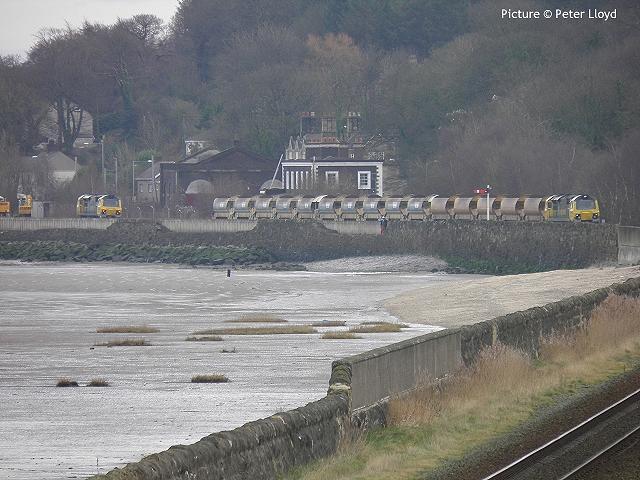
The distant view from the footbridge at Ffynnongroew shows 70 011, 70 015 and a rake of 'autoballaster' wagons. The station closed in 1966 but as the picture shows, its building, one of the original Chester and Holyhead structures designed in a Georgian style by Francis Thompson, remains, as does the goods shed behind. Both are Grade II listed; the station building was abandoned and virtually derelict for many years, but in the 2000s it was rescued and turned into a private residence. The excellent Disused Stations website tells its story.
Mostyn has achieved some fame in the model railway world thanks to the large exhibition layout of the Barrowmore Model Railway Group which is set in the year 1977, a favourite period of many diesel enthusiasts.
Work also took place on the Foryd bridge over the river Clwyd at Rhyl, and Chester station, as these pictures by Chris Coxon, also from 6 January, show.
The contractors had a possession on the track by Platform 3A, and the Through Road, and were working to improve drainage by installing pipes and catch pits. They told Chris that they were planning to 'knock off' at 4 p.m., by which they believed that they would not have completed as much work as planned due to lots of unexpected obstacles, mainly old clay pipework. Chester station building, seen in the background, is also the work of Francis Thompson; the Queen Hotel, to the left, is a little newer, having been built in 1860-61 to the design of Thomas Mainwaring Penson. Penson was based in Chester, and is credited with the design of several of the 'black-and-white revival' buildings in the city centre, including the Grosvenor Hotel.
Wires to Castlefield
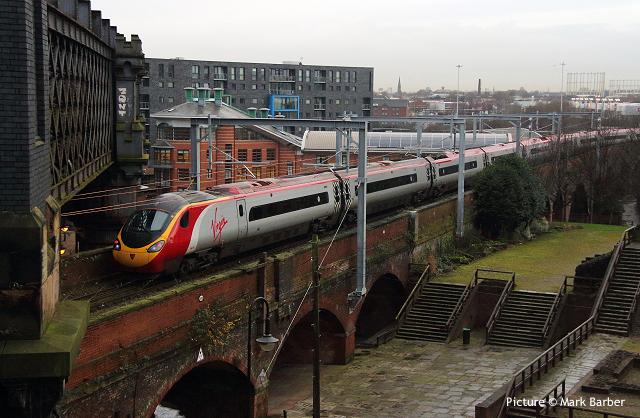
This interesting picture (above) taken by Mark Barber on 27 December reveals that over the Christmas break, overhead wires, part of the Manchester - Liverpool (via Earlestown) electrification scheme, have been installed in the Castlefield Junction area on the gantries which have been there for some months. The train is 390 138 City of London being hauled by 57 316 as 5P09 08:56 empty stock from Longsight Depot to Preston. As can be seen, clearance for the wires under the viaduct is very tight. Manchester - Llandudno trains pass this way, across the site of the Roman Fort, a modern re-creation of which can be seen.
There are two parallel viaducts crossing the South Junction line at this point, both of which once carried lines into Manchester Central station. The southern, and original, one, off the the scene to the left, now carries the Metrolink trams, while the lattice girders seen here, built at the same time as the massive Great Northern goods warehouse, now stands disused. At privatisation, its ownership passed, along with other disused infrastructure, to that obscure body known as the British Railways Board (Residuary). It is a listed structure, and work was done in 2009 to make it safe (see an interesting article on the Forgotten Relics website) and there are plans for further restoration work.
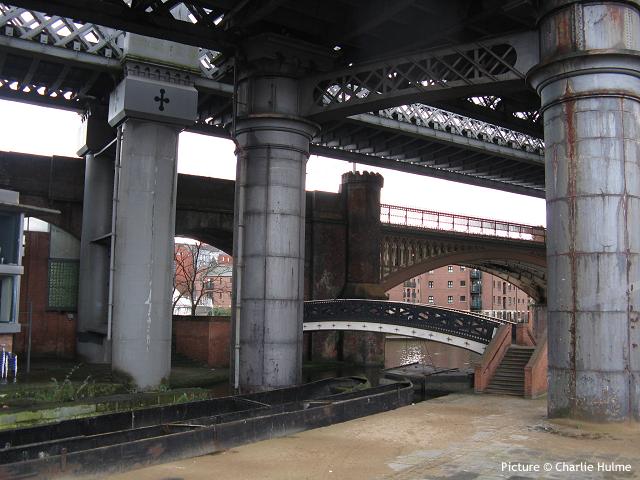
The two viaducts seen from below, amid the wharves of the Bridgewater Canal. The cast-iron bridge in the background carries trains to Liverpool via towards Trafford Park and Warrington Central. A stroll around this area is recommended, not least for the selection of pubs.
While in the area, we are told that crossing/points into the Museum of Science and Industry at Ordsall Lane, which had been disconnected, have been renewed so it is possible to get trains in there from the main line again for the time being.
DRS training runs
The following times are for Monday - Friday crew-training runs, said to be formed of a Class 47 and coaches, which are planned for 7 - 25 January.
5Z45: Crewe Gresty Green up loop dep 09:31, Liverpool Lime Street 10:32 - 10:40 St Helens Junction 11:00 - 11:03 Eccles 11:22 Manchester Victoria 11:31 Stockport 11:58 Macclesfield 12:23 - 12:37 Stoke-on-Trent 13:19 Stoke Sideway Loop arr 13:24.
5Z46: Stoke Sideway Loop dep 13:39 Macclesfield 14:00, Stockport 14:13, Manchester Victoria 14:59, Eccles 15:18, Warrington Bank Quay 15:39 - 15:44 Crewe 16:08 - 16:13 Crewe Gresty Green 16:19.
Observation at Stockport at 14:13 on 7 January revealed no such train, but it may have run early or late. Any sightings and pictures welcome.
It seems that the idea is to familiarise staff for future passenger workings in the North West, although we imagine this will be charter trains rather than for Northern Rail. DRS Training runs are also taking place on the Cumbrian Coast line, where there are plans to run a loco-hauled service train, primarily for workers at Sellafield, as piloted for a few weeks some time ago.
Helsby People Mover?
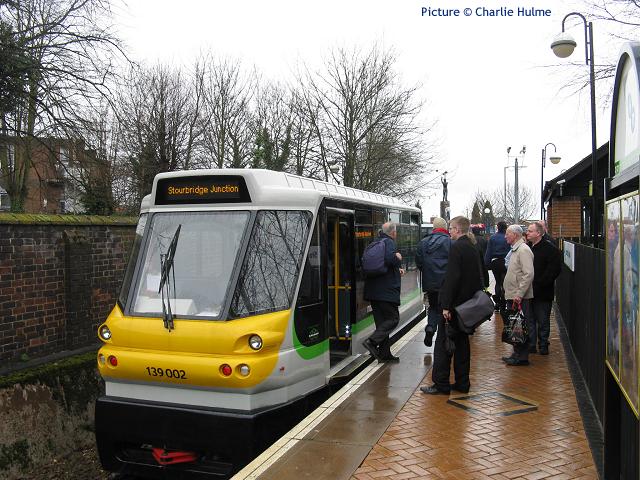
According to an article in the Chester Chronicle of 3 January, Chester West and Cheshire Council has commissioned a report on a proposal to run a regular service using a Parry People Mover railcar on the Helsby - Ellesmere Port line which at present just sees a token handful of passenger trains each day.
The North Cheshire Rail Users Group first raised this idea in 2007, inspired by the operation on the short Stourbridge branch (see our picture above) and a visit by Mr Parry. Their website says 'It is thought that the project would require an investment in the order of £2.4M. NCRUG will continue to pursue this as a viable alternative to the present desultory service which would be cheap to operate and give a usable frequent service.'
The Stourbridge branch vehicles, with their lightweight construction, are not allowed to mingle with normal trains on the same track, and the Ellesmere Port route is, of course, used by heavy freight trains including imported coal. However the line is double track, and apparently the idea would be to convert the 5½-mile route to separate single lines, one for the freights and the other for the People Mover, and at Ellesmere Port the non-electrified platform line would be used. A small depot for the vehicles would have been created somewhere on the line.
There are two intermediate stations, Ince & Elton and Stanlow & Thornton; the latter serves the Stanlow oil refinery (once Shell, now owned by Essar Oil of India) which once dispatched its products by rail, but now relies on pipelines and road tankers.
If this 'comes off' it would certainly add variety to the local rail scene, but it seems a poor substitute for either a proper service to and from Warrington or an extension of the Merseyrail electrics from Ellesmere Port to Helsby or beyond. Mr Parry certainly deserves a medal for his perseverance in attempts to get his light rail ideas adopted.
What a relief - 29 December report by Charlie Hulme
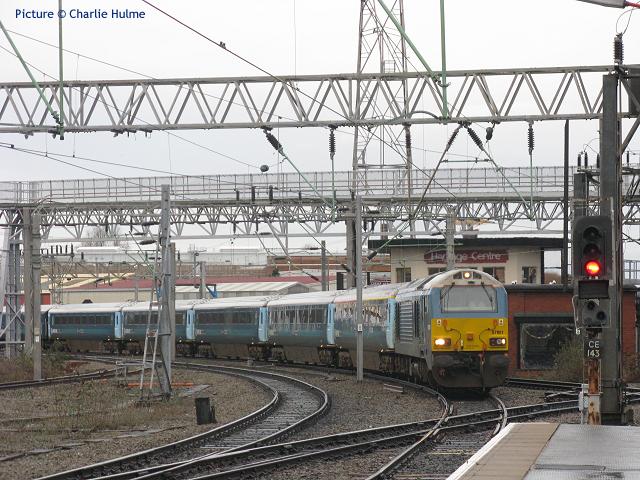
On 29 December, after a frustrating time due to floods the week before, I set out to travel on the second of two Saturdays of Arriva Trains Wales 'boat train' specials, aiming for the 14:27 Crewe - Holyhead which I would ride to Chester. This time, there was no problem: above, 67 001 brings the inbound service into Platform 9, making proper use of this platform which was extended in the 1985 alterations specifically to handle loco-hauled trains from the North Wales line.
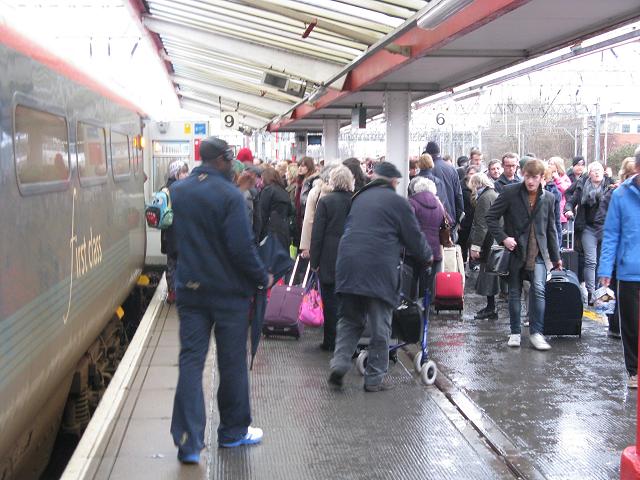
Messages from people on the board the train told the assembled 'cranks' (as our friends on the railway like to call us) that the incoming train was 'packed to the gills' and so it proved to be. The passengers and their luggage, some of which had been loaded into the Driving Van Trailer, took a considerable time to alight, causing some conflict with the many people wishing to get on, as can be seen.
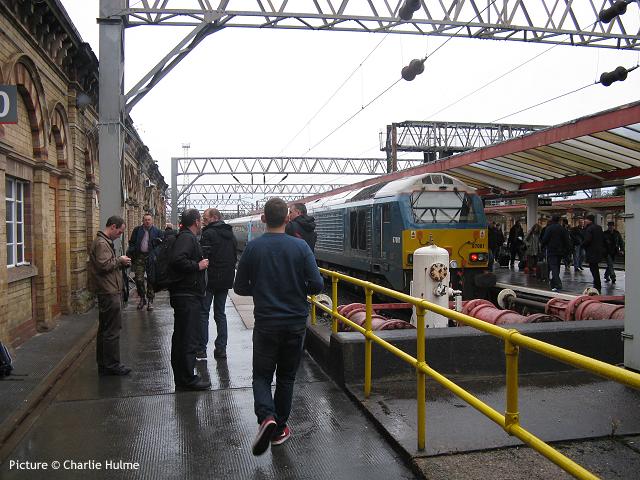
Also to be expected was the presence of railfans, of all ages, to take advantage of this daytime opportunity from Crewe; the Monday - Friday Premium Service between Holyhead and Cardiff now runs via Wrexham. I spoke to one fellow traveller who explained that he 'needed 67 001 for haulage' so he was happy. Personally I was happy to travel behind (or even in front of!) any loco.
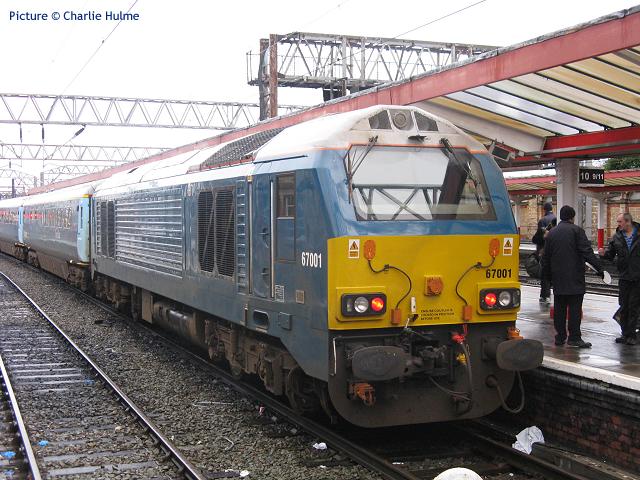
How long since this once-common picture of a locomotive 'on the blocks' has been seen here ? Memories abound of the 1990s when Class 37/4s would bring in a North Wales train and another would appear from the siding provided for the purpose to take the train out.
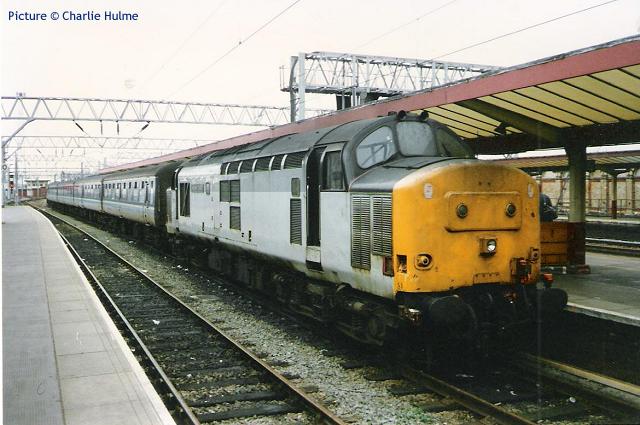
Here's an example from 1995, with 37 417 Highland Region, which was in the North Wales fleet until 1997 but ever received the Regional Railways livery.
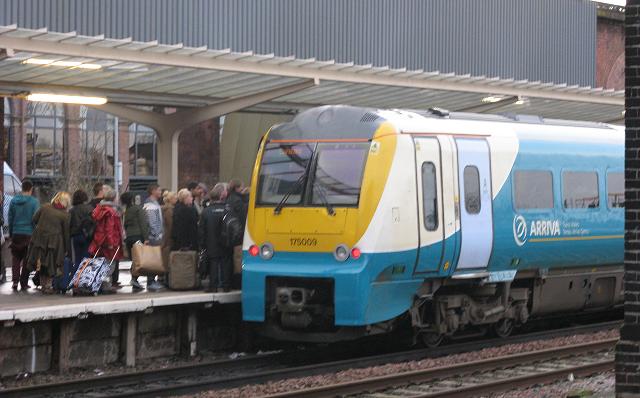
The 'relief train' was not booked to stop until Llandudno Junction, being intended mainly for ferry passengers, but a number of people for intermediate stations also boarded, and found themselves obliged to transfer at Chester to a Llandudno service formed of two-car 175 002.
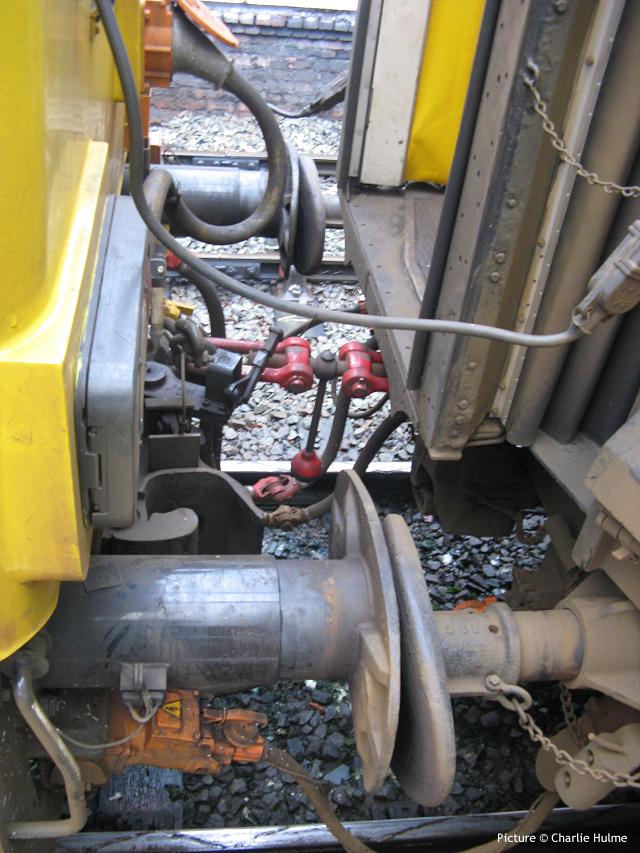
The trip also have me a chance to have a look at the coupling connections in use for this push-pull operation. The 'buckeye' coupler on the loco is swung aside and that on the coach is dropped down, the actual coupling being by means of the red screw-coupler which is carried inside the loco when not in use. The collars are in place on the coach buffers, as required when the screw coupler is used.
The orange sockets and their cables under the buffers are for the train heating power and the pair of Railway Clearing House (RCH) standard cables (centre of picture) and connected between the loco and the coach. The RCH cables have four functions, but only one is in use here. Their primary job is to carry Train lighting on-off commands, just a short burst of power when a button is pressed or on older coaches, a sprung rotary switch. The next job is an overlaid cab to cab/guard's van communication and Public Address function, which is why they are connected here to the engine. They are also capable of carrying a TDM (Time Division Multiplex) digital control signal between a DVT and loco - not the case here, as class 67 are not fitted with this. The final type of signal carried over the cables, and for which the class 67 are fitted (along with all the latter 47/7 conversions), is a four position signalling indication used between a Propelling Control Vehicle (PCV) and the Locomotive, which was used for communication between drivers of trains reversing into mail terminals such as the one at Dallam. The latter operation looks superficially the same as DVT and loco but needs a driver on the engine, and another in the PCV.
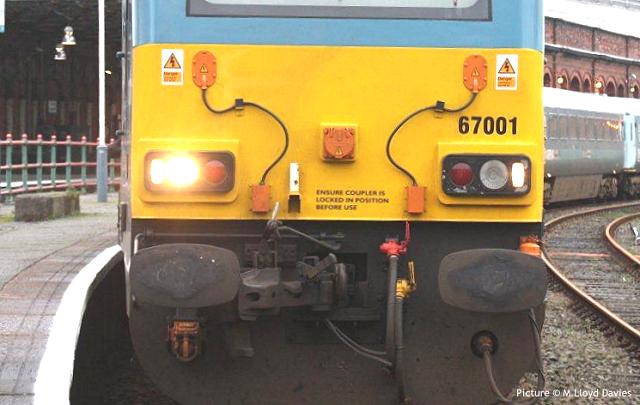
The actual direction and throttle control signals are conveyed through the AAR (American Association of Railroads) multiple control cable from the DVT to the Class 67 locomotive which uses the socket in the centre of the cab front (Picture above by M.Lloyd Davies); the cable is carried inside the loco when not in use. The DVTs for Arriva, have been converted with an interface system between the TDM system and the AAR system; the DVT cab retains the original control handles. Special thanks to 'Concrete Bob' for help with this item.
Thunderbird news
It's time for some clarification of the changes to the Virgin Trains fleet in the new timetable. To quote and entry from the Porterbrook leasing company's website dated 4 January 2013:
As part of the extension of the
West Coast franchise, Porterbrook has extended its lease for the set of
Mk3 coaches with Virgin. With regards to the remaining seven
class
57/3 locomotives that Virgin used for recovery and diversional running,
three have been leased to Direct Rail Services and four have been sold
to West Coast Railways.
The Mk3 'Pretendolino' set does not, as we understand it, have any regular work, however, but will be used when required.
Porterbrook are clearly keen to get some used out of the Mk3 coaches they own: they have made available a fascinating brochure (PDF download) which gives extensive details of the Mk3 stock, and includes the following:
The flexibility of the Mk3 stock
allows it to be configured to meet differing business requirements,
offering:
• Unrestricted seating layouts
• Flexible train length for optimal utilisation
• Electric or Diesel locomotive haulage
• Wide range of upgrade options
Vehicle maintenance is simplified by all traction equipment being on
the locomotive, and track access charges are low. Recent track force
modelling has shown that a train with only 4 powered axles followed by
a train of lightweight axles actually produces less track damage than
large numbers of heavy and rotationally stiff axles on new EMU trains.• Flexible train length for optimal utilisation
• Electric or Diesel locomotive haulage
• Wide range of upgrade options
Various modern locos suitable for use with Mk3 coaches are listed, including the new Class 68 diesels being built for DRS. We had better refrain from comment.
As for the four locos sold to West Coast, these are the four Arriva blue examples, 57 313 - 316, so we can look forward to seeing them in drab maroon livery hauling charter trains in the near future. One wonders how much they were sold for, and how WCRC raised the money, but of course nobody's going to tell us.
Mince Pies at Llangollen - report by George Jones
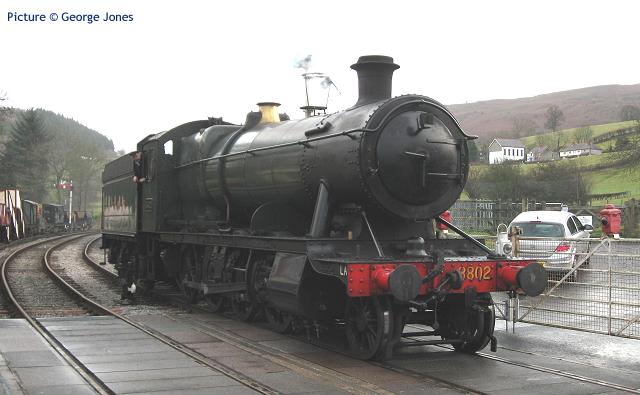
After one day off the festive activities at Llangollen resumed on Boxing Day with the Mince Special trains. GWR 2-8-0 3802 covered these trains which ran until until 1 January. However the discovery of a landslip on the riverside immediately west of Glyndyfrdwy lead to a track inspection before the first train of the day proceeded towards Carrog. As a safety precaution it was decided not to run train services west of Glyndyfrdwy pending further investigation of the site of the slip and the needs for a repair to be initiated in the new year.
Trains terminated at Glyndyfrdwy (above) with the loco run round providing the entertainment during the stopover which involved opening and closing the level gates several times to accommodate the manoeuvre. The shortened run also saw the departure times from Llangollen revised to 11:15, 13:15 and 15:15. Although Glyndyfrdwy station is not manned at this time of the year, it became possible for station staff to be rostered to open the station building and provide hot drinks, a warm fire and facilities in the latter part of the week through to New Year. Passengers intending to join at Carrog have been advised to come forward to Glyndyfrdwy for the train.
A press statement said: 'Llangollen Railway regrets the disruption to visitors' plans for visiting the Dee Valley for the train ride through to the terminus at Carrog. The riverside situation requires a detailed assessment as to the repair which may be needed, but we will be unable to put this in hand until after the New Year period. In the meantime, we trust our visitors will still enjoy the shorter run by steam train through to Glyndyfrdwy and take advantage of the opportunity to explore the Welsh countryside."
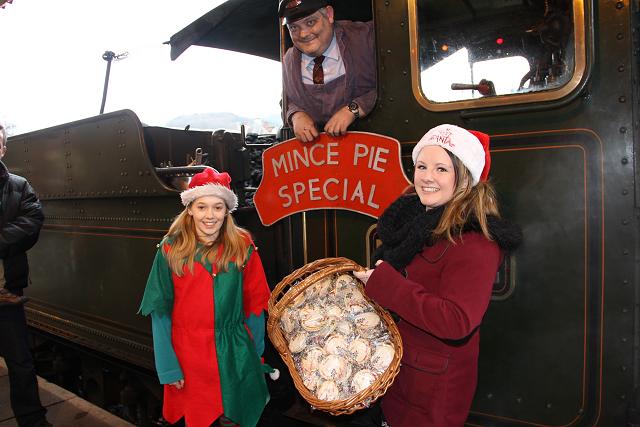
Whilst the reduced journey has been a disappointment for many passengers during this period, most are appreciative of the situation and concerned for its timely resolution. Above: Chloe and Kayleigh line up the Mince Pies for Charlie Brook on the engine. See also an ITV News report.
Train services resume from 2 February with a railcar service, and steam train start on 3 February: see the Llangollen Railway website for details.
A narrow-gauge day out - report by Steve Morris
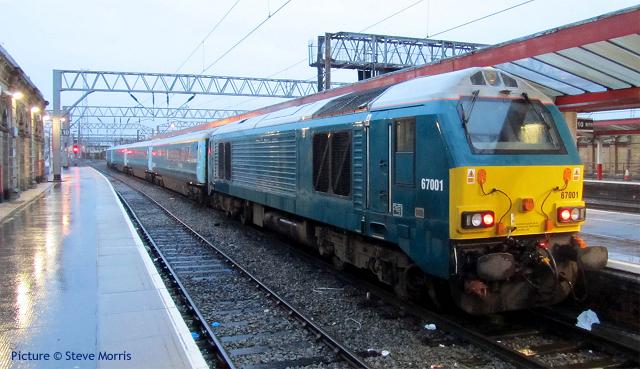
I decided to join a group of other North Wales Railway Circle members to cover the Ffestiniog and Welsh Highland Railway for a circular trip on Saturday 29 December. An added bonus was being able to incorporate the loco-hauled Holyhead/Crewe relief services on both legs across the coast. £29 bought me a "Ffestiniog Round Robin" ticket from Crewe that covered the mainline sections and Ffestiniog Railway. Having arrived on the 03:38 ex Holyhead, 67 001 was found in bay platform 9 platform at Crewe (above) on top of the "WAG" coaches.
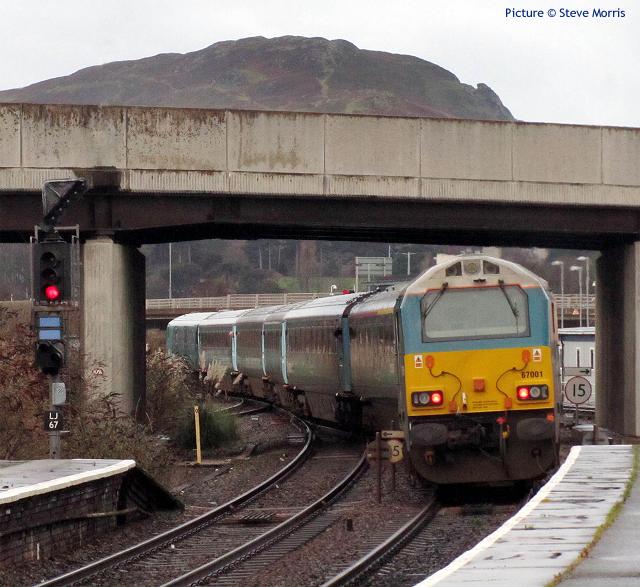
Departure was bang on time at 08.37, Driver Dave Trains in charge (no surprise there). Slack timing alongside the need to follow a 'stopper' out of Chester meant a booked 10-minute stop at Chester plus a 5-minute wait outside Rhyl but arrival at Llandudno Junction was still 2 minutes early at 09:54. Above, the train departs for Holyhead.
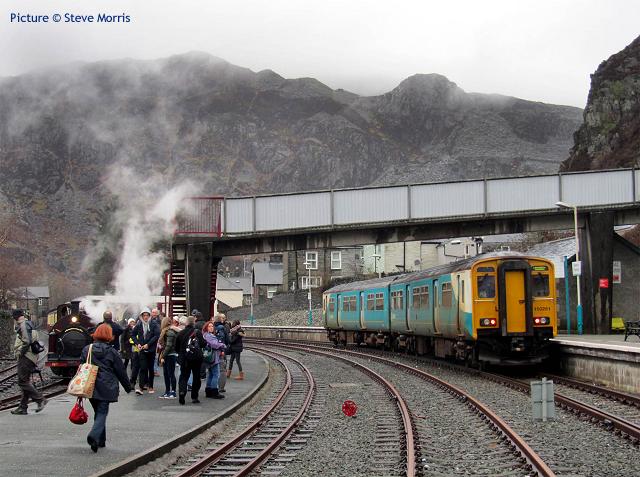
I met up with fellow members. then on to 150 251 for an on-time departure for Blaenau Ffestiniog at 10:34. Significant improvements have been made to flood defences along the Conwy Valley line, without these I am sure we would not have been able to get through to Blaenau given the huge amount of water around. We were on time at Blaenau (above) ...
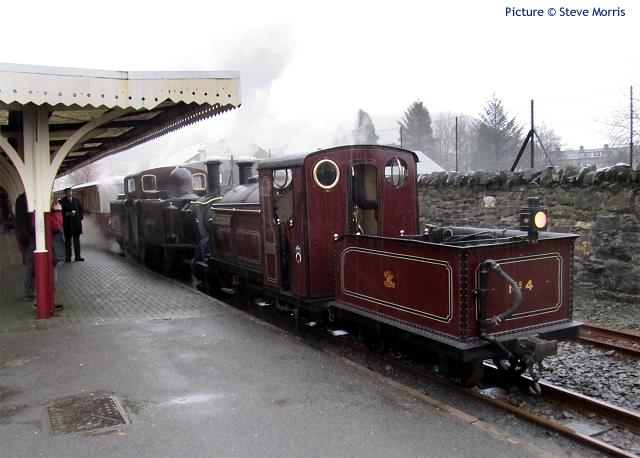
... where we joined the Ffestiniog train loco No. 4 Palmerston and No. 10 Merddin Emrys for a slightly late departure for Porthmadog, pouring down with rain of course (!)
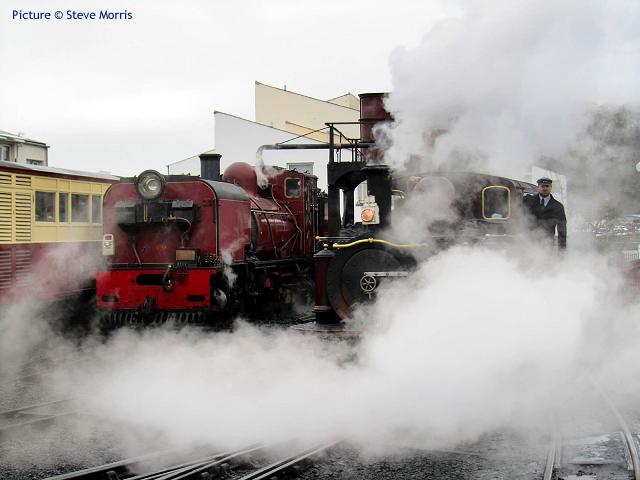
No chance to make up the lost 6 minutes so arrival at Porthmadog (above) was at 13:06. No problem though, a 50-minute connection was on the cards anyway. Time to obtain the final ticket for the day. Even though there does not seem to be an official rule, producing my Ffestiniog Round Robin ticket secured a 50% discount. £11 later and I was in 'Spooners' pub on the platform to meet up with my fellow travellers plus other members who had decided to do the WHR both ways. Departure for Caernarfon was at 13:50.
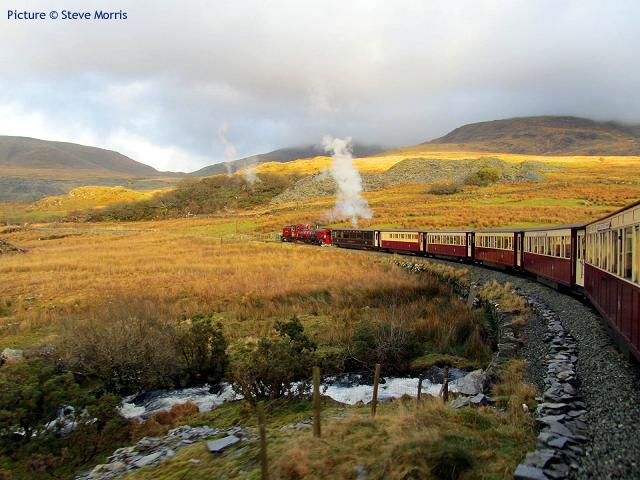
Our group managed to secure the last coach and with ex-South African Railways Beyer-Garratt No 138 up front following a pull-back onto The Cob, an on-time departure was made. By now the weather had picked up giving great views along the route to Caernarfon, with many flooded areas visible en route: Pont Creosor car park being under several feet of water.
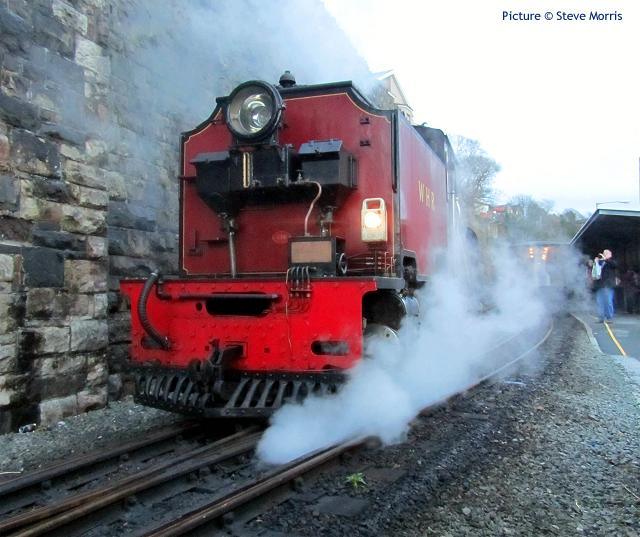
The end of the line at Caernarfon (above) was reached 5 minutes early. Whilst most of the others had time to head off to 'The Black Boy' for a few beers, I was off to Bangor station to pick up the 17:50 for Crewe. This was the 17:15 relief from Holyhead, with 67 001 up front and an on-time departure from Bangor.
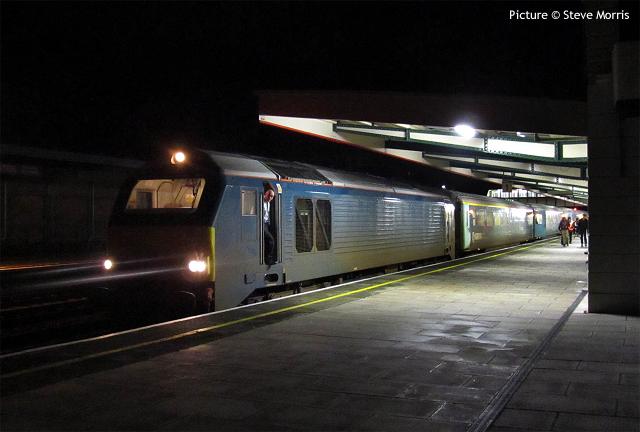
Limited stops across the coast got me back to Crewe (above) 3 minutes early at 19:29, a 5-minute early departure from Chester (where we were booked to stand for over 10 minutes) helping achieve this. So, a round trip including two loco hauled runs in 'proper' rolling stock plus three and a half hours of steam haulage, all done within 11 hours and for just £40, in this day and age that is exceptional value for money.
What a relief - Part 2
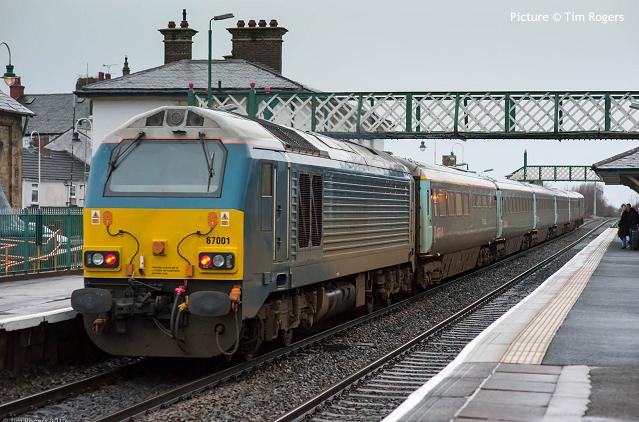
A further selection of pictures from 29 December. Above, 1D04, 08:37 from Crewe, seen at Flint (Tim Rogers).
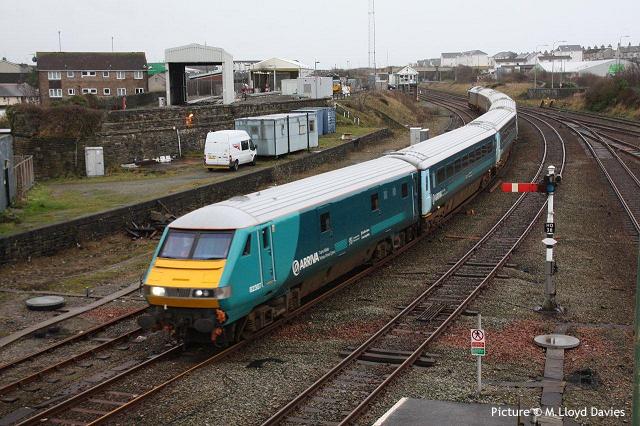
Arrived at Holyhead (M.Lloyd Davies).
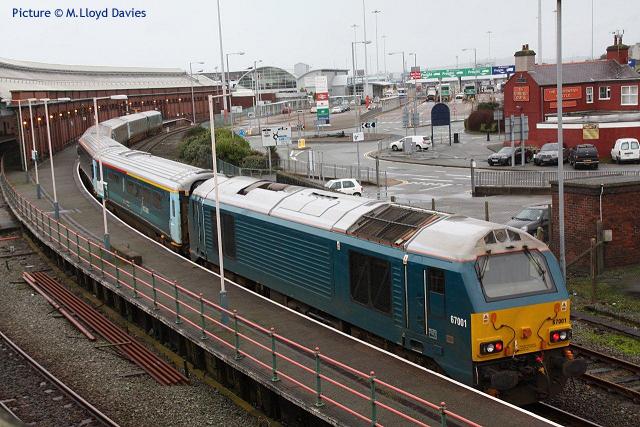
Arrived in Platform 3 (M.Lloyd Davies).
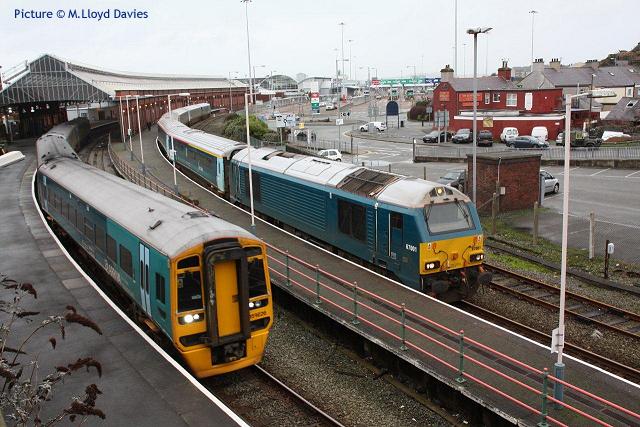
A pair of 158s form the 11:28 to Birmingham (M.Lloyd Davies).
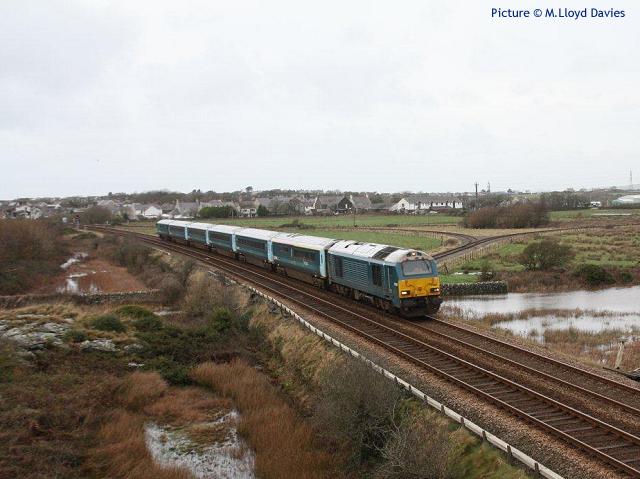
The return train, 12:24 Holyhead - Crewe, passes Valley in the December gloom (M.Lloyd Davies).
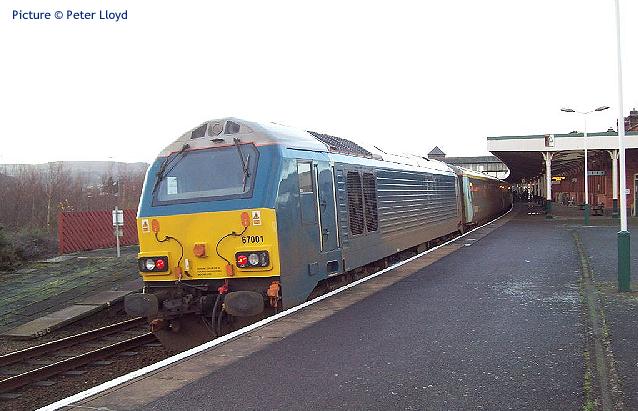
67 001 propelling the 14:27 Crewe - Holyhead, as seen calling at Llandudno Junction at 15:30 Picture by Peter Lloyd.
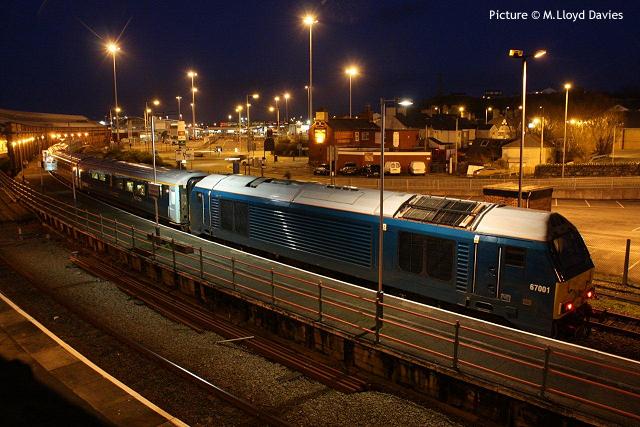
The early evening scene on Platform 3 at Holyhead shortly after arrival of 1D01 14:27 from Crewe (M.Lloyd Davies).
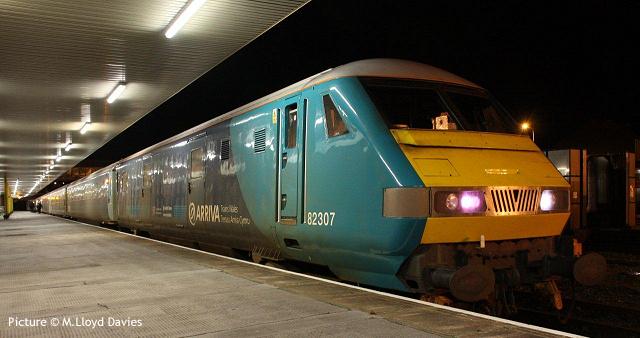
The final working of the day, 20:44 from Crewe, arrived in Platform 1 at Holyhead, with DVT 82307 leading.
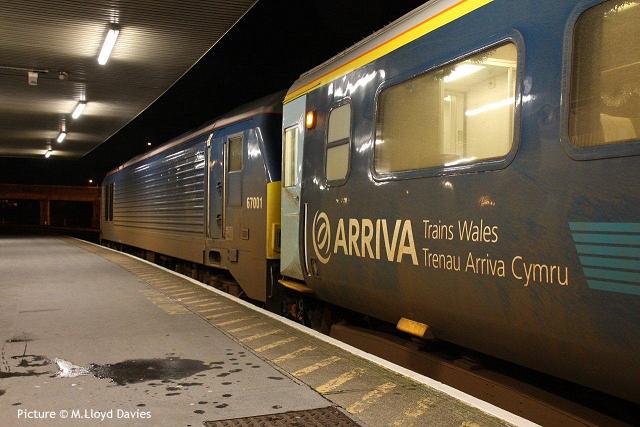
67 001 on the rear (M.Lloyd Davies).
A traveller's tale, by George Jones
I joined other 'cranks' to go out on the 09:10 working from Chester and enjoyed a sparsely filled train to Holyhead, albeit in dismal weather. After the stopover we secured our seats on the return working ahead of the horde off the ferry, with the guard saying he was expecting 230 people to board. These may have been the ones with the reserved seats, because more joined and the train departed very full. It was not so much the extra passengers but their assorted luggage which presented problems. The guard asked for bulky items to be placed in the Van (an unheard of luxury) but even so the aisle and entrances were piled high with the most unusual selection of chests and crates and unshapely baggage despite the guard's request not to block the access. Some paid the £10 excess to travel in the first class and received complimentary drinks.
A few got off at Bangor and Llandudno Junction but even more crammed on board and getting off at Chester was a scramble to get ejected, when even more waited to join than alighted - quite why this was necessary when a local working was available in platform 2 puzzled the driver - and platform dwell time exceeded the norm. The crowd scenes at Crewe (article above) show the consequences of an overloaded train arrival. One was left wondering how the volume of travellers would have been handled had the extra loco-hauled train not been provided, or whether the following Arriva service (158 unit) and Virgin Super Voyager services ran empty. Perhaps we should have sampled one or the other and left the loco-hauled return to the intended travellers.
On the Ship Canal - report by Charlie Hulme
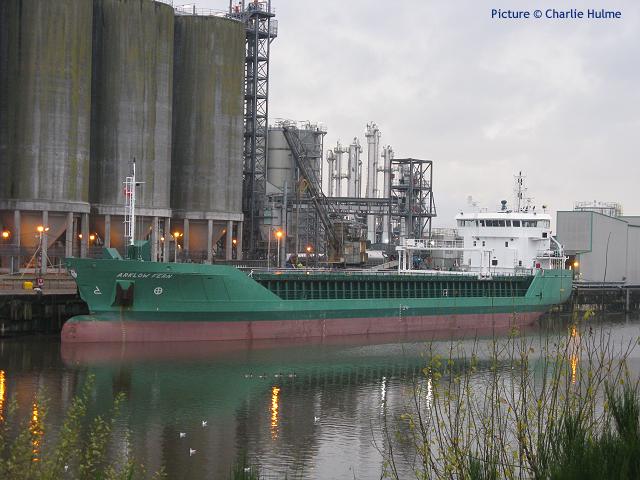
Following tip-off from Dave Sallery that a new flow of grain by sea from France (thanks to the poor harvest in the UK) was serving the Trafford Park 'sweeteners plant' of the Cargill company, on 19 January I took a Metrolink tram to Ladywell, walked down through the almost-disused and depressing West One retail park, past Macdonalds, and crossed a roundabout to a point overlooking the Manchester Ship Canal, where I was able to obtain the above portrait of the unloading MV Arklow Fern, a general cargo ship built in Spain in 2010. This viewpoint relies on a gap in the undergrowth; hopefully it will last until the summer. As I write, on the evening of 7 January, sister ship Arklow Rainbow is berthed there - according to the Ship Canal map on the fascinating ShipAIS website.
The Cargill plant was operated by Cerestar until 2002, and was notable for sending out some of its starch products by rail using the street track in Trafford Park Estate and the Speedlink wagonload network. Some years earlier, it was Brown and Polson, who were the last company on the estate to use a steam locomotive for shunting, until the late 1960s.
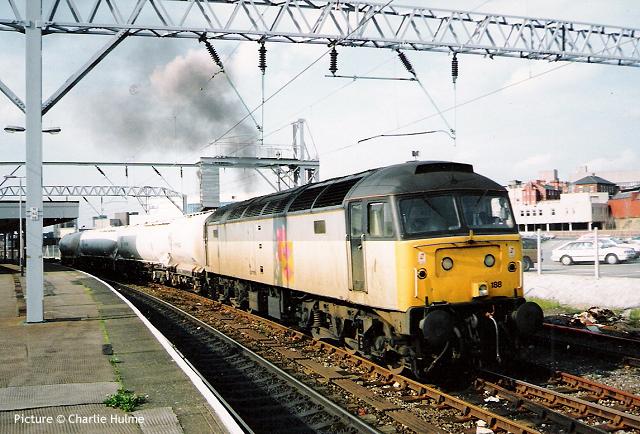
On the basis that there's nothing like a nostalgic digression, here's 47 188 of Tinsley depot, in spring 1991, the dying days of Speedlink, departing Stockport after a wait in the loop with the afternoon trip from Trafford Park to Warrington, which ran via the Mid-Cheshire line and chord line at Hartford, the consist being four Cerestar starch carriers. The line on which the train is running was later removed, only to be put back when the awful new 'Platform Zero' was created. 47 188 was taken out of service in 1998, and eventually scrapped at Crewe in 2005, according to www.class47.co.uk.
A veteran on the measurement train
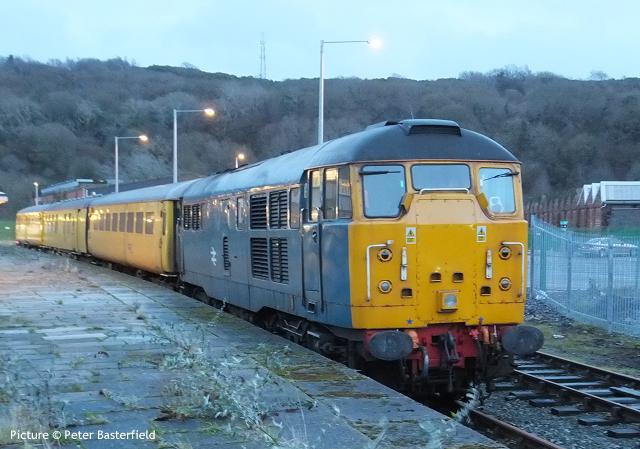
This Network Rail Test Train with 31 106 was stabled in Bangor station all day on 28 December; picture by Peter Basterfield. This is one of the older diesel locos still to be seen on the main line. Built by Brush as D5524 and delivered to Stratford motive power depot (30A) on 26 March 1959, before the introduction of the four-character headcode indicators which later became standard. It later spent time at other Eastern Region depots.
Originally fitted with a Mirrlees engine (Class 30) it was rebuilt in 1967 with an English Electric engine, as part of a programme which covered the whole class after the Mirrlees 'JV' engines were found to suffering fatugue failures, and re-classified as Class 31. Withdrawn from service by British Rail in 1995, 31 106, which proudly wears 1970s-style 'corporate blue' livery, is now owned by Howard Johnston, compiler of RAIL magazine's 'Regional News' column, and managed by Rail Vehicle Engineering Ltd of Derby who hire it to Network Rail.
Our thanks go to the people who wrote promply to us about our original comments in our Radio Survey Train article (last issue) about why two locos were needed. To clarify, the 97xx Driving Trailer vehicles now used by Network Rail are fitted for control by any loco having the British Rail standard 'Blue Star' multiple-unit connection system, including the 31 (note the blue star on the front) and 37, so that was not the reason for the top-and-tailing. Only five driving trailers (9701-3/8/14) are available, one of the five was 'in dock' under overhaul. The other four were probably being used by other test trains; it seems Network Rail prefer to keep them on Ultrasonic Test trains (as above), and the Structure Gauging Train.
North Wales Coast home page Archive Previous Notice Board